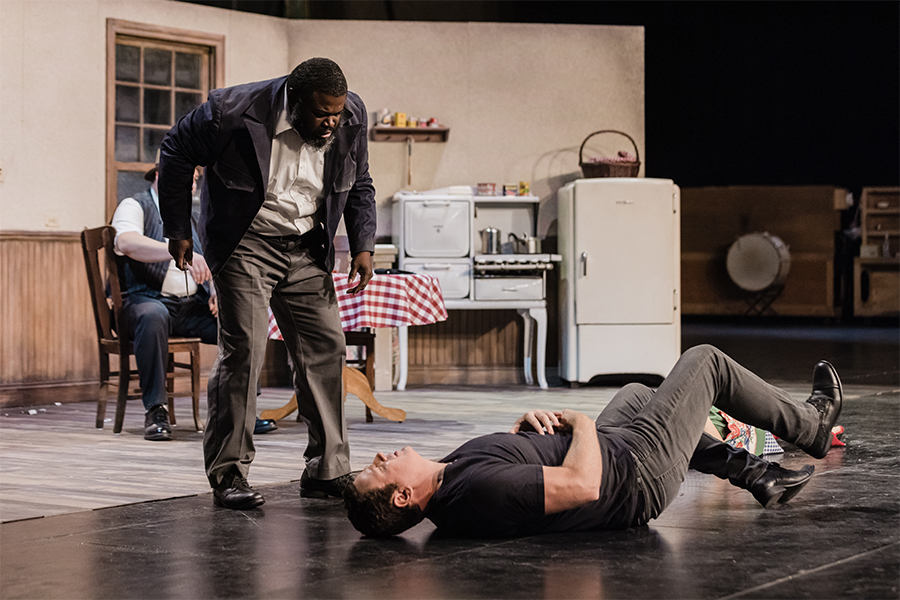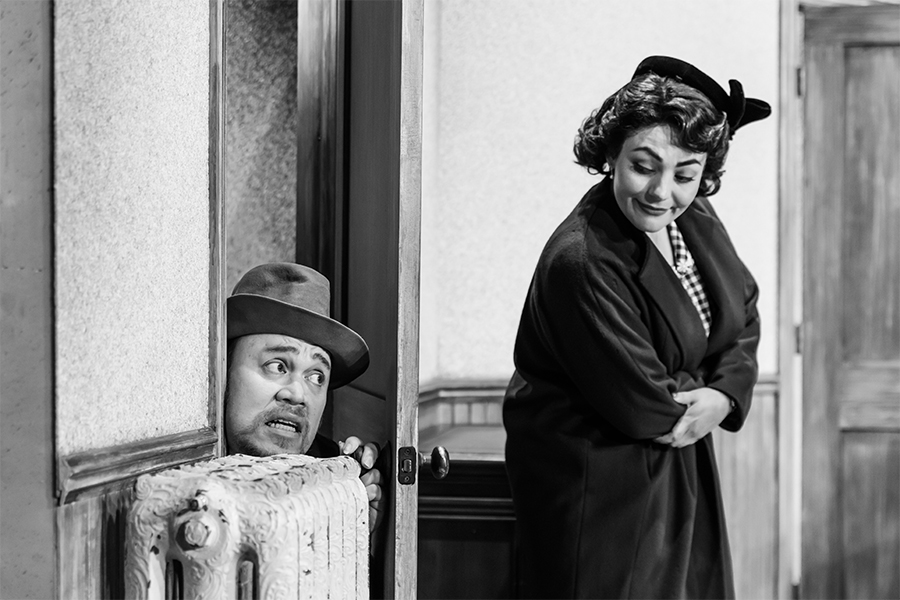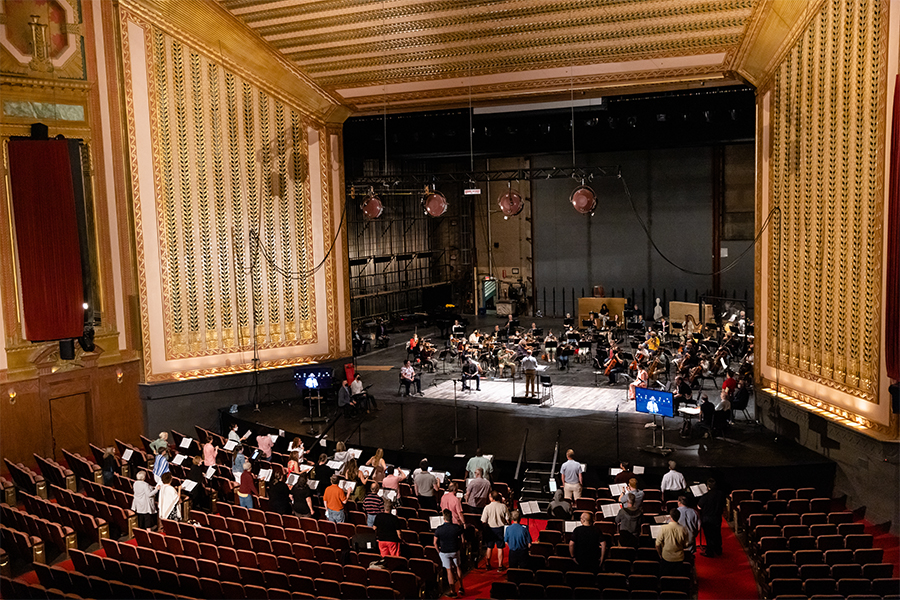September 02, 2021
The making of Pagliacci
In the late 19th century, Italian opera took a step away from fantastical stories of gods and monsters to focus on real life. This style was dubbed "verismo," which translates to "realism." Ruggero Leoncavallo's Pagliacci is a perfect example of this style, as the opera is based on an actual crime from the composer's childhood, in which a family servant was murdered by a romantic rival. Out of nine operas by the composer, Pagliacci is the only work that has remained popular and is often performed as a double-bill with Pietro Mascagni's Cavalleria rusticana. Its enduring success is owed largely to its base in reality. The ability to showcase the best and worst of humanity — humor, passion, jealousy, and ultimately, deadly violence — transcends any specific time period.

Russell Thomas (Canio) stands over Lucas Meachem (Silvio) in the final scene of Leoncavallo's Pagliacci.
In Lyric's new film of Pagliacci, life and art are inextricably intertwined. Production Director Peter McClintok helped create the concept, which was brought to life by an all-star cast, and members of the Lyric Opera Orchestra and Chorus led by Music Director Enrique Mazzola. Pagliacci is the perfect opera to be filmed in a theater, because at its core it is an opera about show people. "There are definitely some locations we used that are not customarily visible to an audience sitting in our theater, yet are extremely familiar to our performers and backstage staff, so the cameras are able to take you to some places that you wouldn't normally get to see," said Cory Lippiello, Lyric's director of artistic programs.
As the opera begins, viewers watch Ryan Opera Center alumnus Quinn Kelsey perform the Prologue outside of the Lyric Opera House. From there, the camera follows him through the stage doors, into the rehearsal department, and ultimately onto the wide-open stage. The Lyric Opera Chorus takes on the role of a live studio audience, watching the taping of a television episode. From the start, viewers will notice that the singers are shown in contemporary street clothes, emphasizing the reality and relevance of the action happening on stage and in the audience. When it comes time for the Commedia — or the show-within-a-show — our film director, Matt Hoffman, set the scene by transitioning from color to black and white and adjusting the aspect ratio to mimic the aesthetic of the first Golden Age of Television.
"The show they watch is modeled after The Honeymooners, with Canio in the Jackie Gleason role, Tonio as Art Carney, and Nedda as Audrey Meadows," said Lippiello. "The rhythms of that scene, punctuated with the laughter and reactions from the chorus are much like a television taping filmed before a live studio audience. The play they are performing features very familiar commedia characters, who each have a specific set of behaviors, much in the same way that sitcom tropes are instantly familiar to us. Then at the end when Canio goes 'off-script,' suddenly the audience is not watching familiar TV but instead a tragic bit of reality television."

Ryan Opera Center alumnus Quinn Kelsey as Tonio and Ailyn Pérez as Nedda during the Honeymooners-inspired Commedia.
When the discussion around Pagliacci moved from a digital concert to a full, filmed production, Lyric looked to its own production staff to design the show in-house. The scenic design is by Maria DeFabo Akin (Properties and Scenic Design Director) and Scott Wolfson (Associate Technical Director), costume design is by Scott Marr (Wardrobe, Wigs, and Makeup Director), and lighting is by Chris Maravich (Lighting Director). The whole production was overseen by our Technical Director Michael Smallwood, who has had a hand in all of the digital programming Lyric audiences have enjoyed this year; resulting in a true team effort to close out our reimagined 2020/21 Season.
The rehearsal period for Pagliacci was a whirlwind. "This show began life as a filmed concert, so we hadn't initially planned to rehearse for multiple weeks the way we would for a staged opera," said Lippiello. "We were able to add a little more rehearsal to the original short period we had secured with the artists, but not everyone was available to start at the same time, as we had several folks coming from other engagements." This meant that the creative team had to figure out how to make the most of their time while still operating in the safest manner possible. In order to spread out the musicians, chorus, and principal artists, it was decided that we would record the audio tracks in advance and have the artists sing along with a playback of their audio while filming. "In the end I think it made it possible for us to have both an outstanding audio recording, and a more theatrically engaging video, since the singers could give more during the filming without having to worry about what was being captured vocally," said Lippiello.

The Lyric Opera Chorus, Orchestra, and principal artists create a full audio recording of Leoncavallo's Pagliacci in the Lyric Opera House.
With only three days to capture the video for Pagliacci, the team had to be extremely intentional when planning the filming schedule. In order to maximize time and the set-ups, the opera was not shot in chronological order. Because artists could rely on their superb audio recording, it was possible to get multiple takes of each scene without losing momentum or getting fatigued vocally.
"One of the most exciting things about this cast is that they are all singing in top form — I'm so thrilled we were able to capture them at this moment in their careers," said Lippiello. "Some of them have sung their roles several times before, but others like Russell Thomas were singing their roles for the first time, which makes it particularly special." Audiences can now see Music Director Enrique Mazzola lead a dream cast, including Russell Thomas (Canio), Ailyn Pérez (Nedda), Quinn Kelsey (Tonio), Lucas Meachem (Silvio), and Eric Ferring (Beppe), along with the Lyric Opera Orchestra and Chorus in this special filmed production of Leoncavallo's Pagliacci, now streaming free on-demand.
